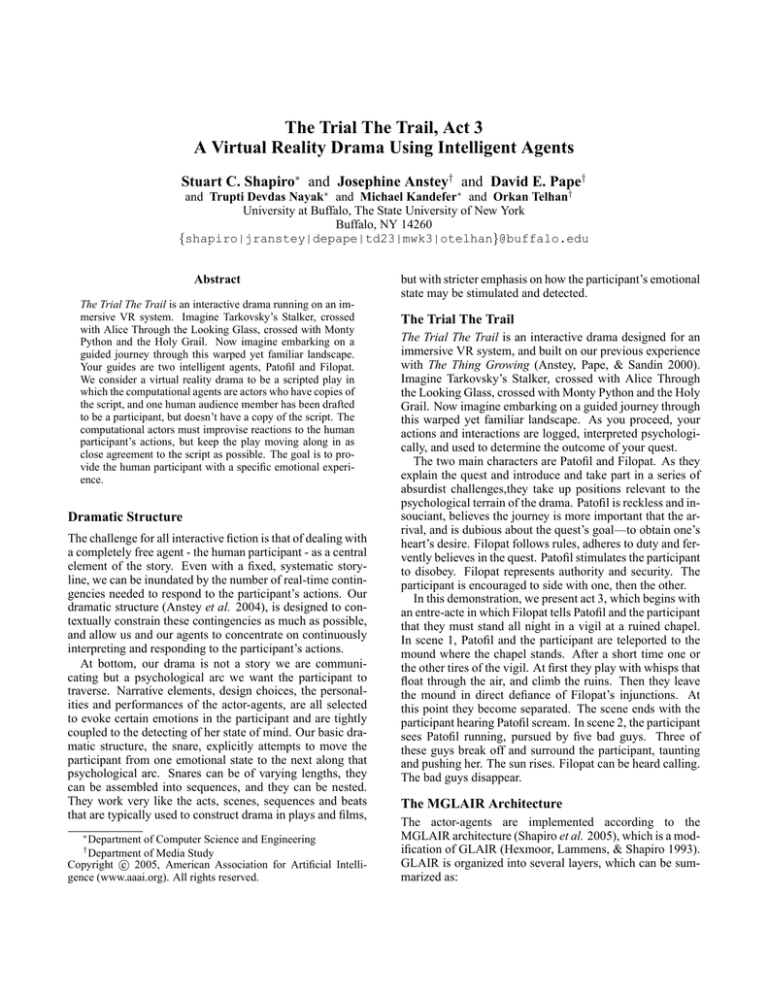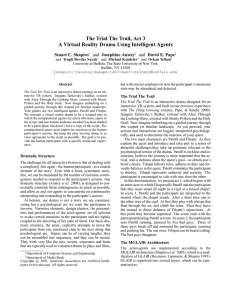
The Trial The Trail, Act 3
A Virtual Reality Drama Using Intelligent Agents
Stuart C. Shapiro∗ and Josephine Anstey† and David E. Pape†
and Trupti Devdas Nayak∗ and Michael Kandefer∗ and Orkan Telhan†
University at Buffalo, The State University of New York
Buffalo, NY 14260
{shapiro|jranstey|depape|td23|mwk3|otelhan}@buffalo.edu
Abstract
The Trial The Trail is an interactive drama running on an immersive VR system. Imagine Tarkovsky’s Stalker, crossed
with Alice Through the Looking Glass, crossed with Monty
Python and the Holy Grail. Now imagine embarking on a
guided journey through this warped yet familiar landscape.
Your guides are two intelligent agents, Patofil and Filopat.
We consider a virtual reality drama to be a scripted play in
which the computational agents are actors who have copies of
the script, and one human audience member has been drafted
to be a participant, but doesn’t have a copy of the script. The
computational actors must improvise reactions to the human
participant’s actions, but keep the play moving along in as
close agreement to the script as possible. The goal is to provide the human participant with a specific emotional experience.
Dramatic Structure
The challenge for all interactive fiction is that of dealing with
a completely free agent - the human participant - as a central
element of the story. Even with a fixed, systematic storyline, we can be inundated by the number of real-time contingencies needed to respond to the participant’s actions. Our
dramatic structure (Anstey et al. 2004), is designed to contextually constrain these contingencies as much as possible,
and allow us and our agents to concentrate on continuously
interpreting and responding to the participant’s actions.
At bottom, our drama is not a story we are communicating but a psychological arc we want the participant to
traverse. Narrative elements, design choices, the personalities and performances of the actor-agents, are all selected
to evoke certain emotions in the participant and are tightly
coupled to the detecting of her state of mind. Our basic dramatic structure, the snare, explicitly attempts to move the
participant from one emotional state to the next along that
psychological arc. Snares can be of varying lengths, they
can be assembled into sequences, and they can be nested.
They work very like the acts, scenes, sequences and beats
that are typically used to construct drama in plays and films,
∗
Department of Computer Science and Engineering
†
Department of Media Study
c 2005, American Association for Artificial IntelliCopyright gence (www.aaai.org). All rights reserved.
but with stricter emphasis on how the participant’s emotional
state may be stimulated and detected.
The Trial The Trail
The Trial The Trail is an interactive drama designed for an
immersive VR system, and built on our previous experience
with The Thing Growing (Anstey, Pape, & Sandin 2000).
Imagine Tarkovsky’s Stalker, crossed with Alice Through
the Looking Glass, crossed with Monty Python and the Holy
Grail. Now imagine embarking on a guided journey through
this warped yet familiar landscape. As you proceed, your
actions and interactions are logged, interpreted psychologically, and used to determine the outcome of your quest.
The two main characters are Patofil and Filopat. As they
explain the quest and introduce and take part in a series of
absurdist challenges,they take up positions relevant to the
psychological terrain of the drama. Patofil is reckless and insouciant, believes the journey is more important that the arrival, and is dubious about the quest’s goal—to obtain one’s
heart’s desire. Filopat follows rules, adheres to duty and fervently believes in the quest. Patofil stimulates the participant
to disobey. Filopat represents authority and security. The
participant is encouraged to side with one, then the other.
In this demonstration, we present act 3, which begins with
an entre-acte in which Filopat tells Patofil and the participant
that they must stand all night in a vigil at a ruined chapel.
In scene 1, Patofil and the participant are teleported to the
mound where the chapel stands. After a short time one or
the other tires of the vigil. At first they play with whisps that
float through the air, and climb the ruins. Then they leave
the mound in direct defiance of Filopat’s injunctions. At
this point they become separated. The scene ends with the
participant hearing Patofil scream. In scene 2, the participant
sees Patofil running, pursued by five bad guys. Three of
these guys break off and surround the participant, taunting
and pushing her. The sun rises. Filopat can be heard calling.
The bad guys disappear.
The MGLAIR Architecture
The actor-agents are implemented according to the
MGLAIR architecture (Shapiro et al. 2005), which is a modification of GLAIR (Hexmoor, Lammens, & Shapiro 1993).
GLAIR is organized into several layers, which can be summarized as:
The Mental Layer (ML) is the layer at which conscious
reasoning takes place. It is implemented by the SNePS
knowledge representation and reasoning system (Shapiro &
The SNePS Implementation Group 2004), and its SNeRE
(the SNePS Rational Engine) acting subsystem. SNePS, in
turn, is implemented in Common Lisp.
The Body Layer (BL) contains the implementations of
the actions that are primitive at the ML, and the low-level
implementations of the agent’s sensors and effectors.
The Environment is built using the Ygdrasil (Pape et al.
2003) virtual reality authoring system, C++, and Python.
Real-time dynamic behaviors and interaction make use of an
event-based structure; messages are passed between nodes
in response to events. Messages include actions such as
loading models, playing sounds, and moving objects.
Timers
Occasionally, an actor-agent is to engage in an activity for a
set amount of time (unless interrupted). To do this, she may
make use of an arbitrary number of timers, which can be set
to expire in some number of seconds, triggering some other
act, and may be paused, restarted, and cancelled. During the
vigil, after 14 seconds of neither Patofil nor the participant
doing anything, Patofil will start giggling.
Contingencies
The main line of the script is written assuming a compliant
participant. Some deviations can be ignored; some are handled while pausing a timer; others may cancel the rest of a
agent’s goal-directed action sequence.
The Cast as a Multi-Agent System
Modalities
MGLAIR (Modal GLAIR) differs from GLAIR in that the
BL is organized into modalities. A modality is a hardware
or software resource utilized by an intelligent agent for either sensing or acting. A single modality can support only a
limited number of behaviors at a time, but behaviors that occupy different modalities can be simultaneous. The modalities used by the actor-agents in The Trial The Trail are animation, hearing, mood, navigation, speech, and vision.
The Trial, The Trail runs on several computers, the ML
and upper BL of each agent on one computer, the lower BL
and the environment on another. Communication is via IP
sockets organized by modality, one socket for each. The
sockets provide the mind-body connection, with the “mind”
running on one computer, and the “body” on another.
Several modalities provide feedback about what the agent,
itself, says or does. This keeps her from starting one action while still performing the previous action. For example,
Patofil’s hearing her own lines prevents her from starting to
say something while she is still delivering her previous lines.
Triggers
Just as a stage actor uses various cues to know when to take
some action or deliver some lines, our actor-agents use triggers that are implemented in the world-model to identify the
actions and locations of the virtual objects, agents, and the
participant. We also use a stage direction agent, similar to
a set manager, that is in charge of certain procedural tasks,
such as initiating the beginning and ending of each scene,
starting and ending the action of other interactive objects
(i.e. the flow of whisps), and controlling the lighting of the
scene (i.e. setting the sun, raising the moon).
The Scripts
Each actor-agent has a script, which constitutes a set of beliefs in its ML specifying how and when it should say its
lines and perform its actions. Some actions are strictly sequenced; some involve arbitrary choice among several possibilities; some are event-driven. The script is expressed in
SNePSLOG (Shapiro & The SNePS Implementation Group
2004, Chapter 7), a symbolic-logic-like interface language
to SNePS.
The cast of computational actor-agents constitutes a multiagent system, especially in act 3, scene 2, where three bad
guys are required to cooperatively harass the human participant. They engage in two types of cooperative behavior:
sequential actions and blocking actions. Just as Patofil perceives her own utterances to maintain the scripted order of
her lines, these agents perceive their own and each others’
utterances to follow the scripted order of their lines. Blocking actions, like jostling or pushing the user, must not be
interfered with. Whenever an agent perceives that another
agent is performing one of these actions, it will only perform actions that will not interfere. This restriction is lifted
when the blocking action is finished, as indicated by a message from the virtual world via the agent’s vision modality.
References
Anstey, J.; Pape, D.; Shapiro, S. C.; Telhan, O.; and Nayak,
T. D. 2004. Psycho-drama in VR. In Proceedings of The
Fourth Conference on Computation Semiotics (COSIGN
2004), 5–13. Croatia: University of Split.
Anstey, J.; Pape, D.; and Sandin, D. 2000. The Thing
Growing: Autonomous characters in virtual reality interactive fiction. In IEEE Virtual Reality 2000. IEEE.
Hexmoor, H.; Lammens, J.; and Shapiro, S. C. 1993. Embodiment in GLAIR: a grounded layered architecture with
integrated reasoning for autonomous agents. In Dankel II,
D. D., and Stewman, J., eds., Proc. FLAIRS 93. The Florida
AI Research Society. 325–329.
Pape, D.; Anstey, J.; Dolinsky, M.; and Dambik, E. J.
2003. Ygdrasil—a framework for composing shared
virtual worlds. Future Generation Computer Systems
19(6):1041–1049.
Shapiro, S. C., and The SNePS Implementation Group.
2004. SNePS 2.6.1 User’s Manual. Department of Computer Science and Engineering, University at Buffalo, The
State University of New York, Buffalo, NY.
Shapiro, S. C.; Anstey, J.; Pape, D. E.; Nayak, T. D.; Kandefer, M.; and Telhan, O. 2005. MGLAIR agents in a
virtual reality drama. Technical Report 2005-08, Department of Computer Science & Engineering, University at
Buffalo, Buffalo, NY. Submitted for publication.





